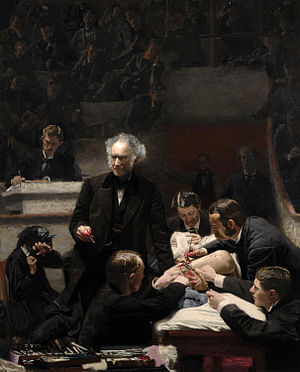The Gross Clinic: Difference between revisions
No edit summary |
No edit summary |
||
| Line 14: | Line 14: | ||
'''Location:''' Philadelphia, Pennsylvania | '''Location:''' Philadelphia, Pennsylvania | ||
[[File:Eakins.jpg|right]] | |||
'''Description of Artwork:''' ''The Gross Clinic'', Eakins most notable painting and arguably one of the most important paintings of the 19th century, shows a scene in an operating room. The painting gives gruesome detail, like blood on the surgeon's hands. It was called "too bold" for its "attention to facts." <P> | '''Description of Artwork:''' ''The Gross Clinic'', Eakins most notable painting and arguably one of the most important paintings of the 19th century, shows a scene in an operating room. The painting gives gruesome detail, like blood on the surgeon's hands. It was called "too bold" for its "attention to facts." <P> | ||
'''The Incident:''' ''The Gross Clinic'' was refused | '''The Incident:''' ''The Gross Clinic'' was considered "too bold". The painting was refused admission into the American section of the Centennial Exhibition. Later it was admitted to the medical section, where it was received unfavorably. Eakins' passion for realism also got him fired from many teaching jobs. In 1886 Eakins was a professor of painting at the Pennsylvania Academy of Fine Arts. During one of the classes Eakins removed the loincloth from one of the male models during a lecture that included female students. Although the school gave life drawing classes with nude models for women, this was a co-ed class, where it was not permitted. The school said that he must be more respectful of modesty or resign. Eakins resigned, feeling that women should not be shielded from the male anatomy. Some of Eakins' other practices--such as encouraging students to model nude for each other in private classes and requiring the students to take part in dissections could have also led to him being pushed out of the Philadelphia art world. Eakins had also taught at the Philadelphia Sketch Club and the Academy Art Club, both of which he was also soon expelled from.<P> | ||
'''Results of Incident:''' Eakins stopped painting during the year of 1886 and did not resume again until the summer of 1887. He limited his painting to portraits. His teaching career was over by the time he was fifty.<P> | |||
'''Source:''' Censorship, A World Encyclopedia, ed. D. Jones | '''Source:''' Censorship, A World Encyclopedia, ed. D. Jones | ||
[[Category:1875]] | |||
[[Category:1886]] | |||
[[Category: | [[Category:1870s]] | ||
[[Category:]] | [[Category:1880s]] | ||
[[Category:]] | [[Category:19th century]] | ||
[[Category:North America]] | [[Category:North America]] | ||
[[Category:Nudity]] | [[Category:Nudity]] | ||
[[Category: | [[Category:Other]] | ||
[[Category:Painting]] | [[Category:Painting]] | ||
[[Category:Thomas Eakins]] | [[Category:Thomas Eakins]] | ||
{{DISPLAYTITLE:<span style="font-style: italic;">The Gross Clinic</span>}} | |||
{{DEFAULTSORT:Gross Clinic, The}} | |||
__NOTOC__ | __NOTOC__ | ||
Revision as of 03:05, 18 January 2012
Date: 1875 1886
Region: North America
Subject: Other Nudity
Medium: Painting
Artist: Thomas Eakins 1844 - 1916)
Confronting Bodies: Pennsylvania Academy of Fine Arts administrators, members of the Philadelphia Sketch Club
Date of Action: 1875, 1886
Location: Philadelphia, Pennsylvania
Description of Artwork: The Gross Clinic, Eakins most notable painting and arguably one of the most important paintings of the 19th century, shows a scene in an operating room. The painting gives gruesome detail, like blood on the surgeon's hands. It was called "too bold" for its "attention to facts."
The Incident: The Gross Clinic was considered "too bold". The painting was refused admission into the American section of the Centennial Exhibition. Later it was admitted to the medical section, where it was received unfavorably. Eakins' passion for realism also got him fired from many teaching jobs. In 1886 Eakins was a professor of painting at the Pennsylvania Academy of Fine Arts. During one of the classes Eakins removed the loincloth from one of the male models during a lecture that included female students. Although the school gave life drawing classes with nude models for women, this was a co-ed class, where it was not permitted. The school said that he must be more respectful of modesty or resign. Eakins resigned, feeling that women should not be shielded from the male anatomy. Some of Eakins' other practices--such as encouraging students to model nude for each other in private classes and requiring the students to take part in dissections could have also led to him being pushed out of the Philadelphia art world. Eakins had also taught at the Philadelphia Sketch Club and the Academy Art Club, both of which he was also soon expelled from.
Results of Incident: Eakins stopped painting during the year of 1886 and did not resume again until the summer of 1887. He limited his painting to portraits. His teaching career was over by the time he was fifty.
Source: Censorship, A World Encyclopedia, ed. D. Jones
